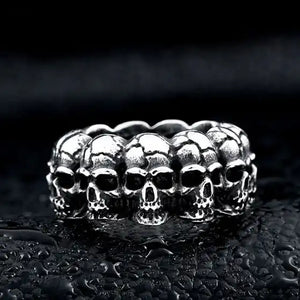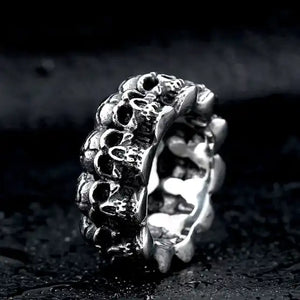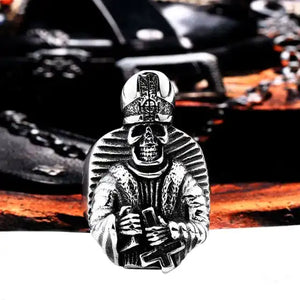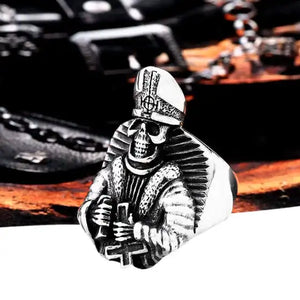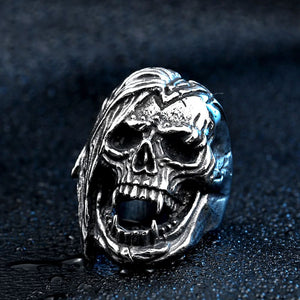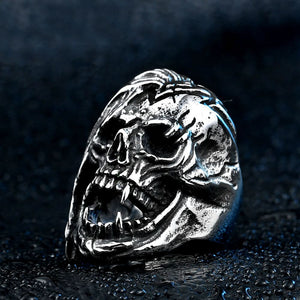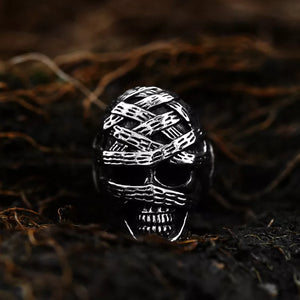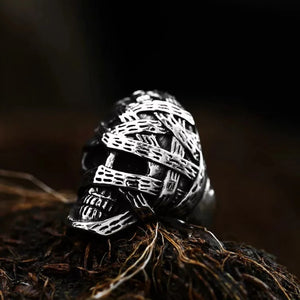Table of Contents
Skulls have been a part of human culture for centuries and have roots in many different cultures across the globe. They are commonly associated with death, but can also act as a display of power or symbol of respect.
In some cultures, skulls can even be seen as a way to reconnect with the spirit world and were often used in religious ceremonies.
Let's dive into some of the major cultures who have used skulls as a part of their customs and traditions.
Related Reading: Skull Rings: What They Mean and How to Wear Them
Cultural Associations
Aztecs

Aztecs engaged in brutal warfare and would often decapitate prisoners of war upon their capture.
The skulls of these prisoners were placed on a large rack - known as a tzompantli - that served to mock the conquered enemies and instill fear into potential invaders.
The largest known rack is the Hueyi Tzompantli, which contains tens of thousands of skulls. The estimated number of skulls is around 60,000. Excavations have also uncovered additional, smaller racks adorned with the skulls of human sacrificial victims.
Mayans

Chichen Itza was one of the largest Mayan cities and is known for its many temples and iconic landmarks, such as the Temple of the Warriors, the Sacred Cenote, and the Platform of the Eagles and Jaguars.
However, one of its most chilling landmarks is the Skull Platform - a stone wall carved with the faces of over 500 skulls. The platform is located in front of the Temple of the Warriors and is thought to have been used for the ritualistic display of skulls.
Mexico

Mexico is known for its rich culture and vibrant festivals. One of the most famous festivals is Dia de los Muertos, or "Day of the Dead". This festival is to celebrate and remember those who have passed away.
The holiday is celebrated with food, music, and colorful decorations. One of the most iconic symbols of this is the sugar skull.
Sugar skulls are often given to children and adults alike during the Day of the Dead celebrations. The skulls are meant to represent deceased loved ones and are decorated with brightly colored icing and often adorned with beads, sequins, or other small decorations. While sugar skulls may seem morbid to some, they are actually seen as a celebration of life and death in Mexican culture.
If you're interested in learning more, check out our blog post on the complete guide to sugar skulls.
Biker Culture

The use of skulls in biker culture can be traced back to the Hells Angels, who were founded in 1948. The Hells Angels logo - known as "Death's Head" - is a skull with wings and has become an iconic symbol of the biker subculture.
Skulls are often seen on biker jackets, vests, and helmets. They can also be found on biker jewelry, such as rings and necklaces.
Skull rings and apparel are popular in biker culture because they represent the danger and rebel attitude associated with the lifestyle. They are also seen as a way to show respect for fallen riders, among other reasons they wear rings.
Related Reading: 6 Biker Symbols to Know About
Pirate Symbolism

From Pirates of the Caribbean to Captain Hook, pirates have been a popular culture icon for centuries. One of the most recognizable aspects of pirate culture is the skull and crossbones symbol.
The skull and crossbones are commonly seen on the Jolly Roger, the pirate flag flown to identify a ship's crew as pirates. It also served to intimidate merchant ships into surrendering, or otherwise facing the consequences.
The skull and crossbones are still a popular symbol today, and looks great on a uniquely styled, pirate-themed ring.
Goth Culture

Skulls are prevalent in gothic fashion, appearing on clothing, jewelry, and other accessories. They are also a large part of gothic art, often appearing in dark and foreboding images.
There is a misconception that goths are obsessed with death, but in reality, they simply find beauty in things that others might consider dark or morbid. They embrace death and see it as a natural part of life.
Celebrity Ties

What do Keith Richards and Johnny Depp have in common? They're friends who both have an appreciation for skull apparel!
Keith Richards of the Rolling Stones is known for his iconic skull ring, which he has been wearing for decades. He is often credited with popularizing the trend of wearing skull jewelry. He has been featured wearing it in many magazines and interviews, and even has a line of skull-themed jewelry.
Johnny Depp is another celebrity with a love for skulls. He has been photographed wearing skull rings, necklaces, and even a scarf. His collection of rings alone is said to be worth over $100,000.
Depp has even gone so far as to have a skull tattooed on his right bicep.
Military Use

Skulls are a popular symbol among military personnel and are used as a way to show power and strength. The United States Army has used them on their tanks and helicopters. They are also commonly seen on the uniforms of special forces units.
The Punisher skull - derived from a Marvel Comics character, "The Punisher" - is also popular among military members. It is often used as a symbol of justice and vengeance, but also serves as a symbol that unites those who have served. It is commonly displayed on patches, t-shirts, tattoos, and it even has its own ring.
Hinduism

In Hinduism, the skull is often associated with the goddess Kali, who is often depicted wearing a necklace of severed heads or skulls called "the mundamala".
Kali is the goddess of death, destruction, and time. She is often associated with violence, but is also seen as a powerful protector of the weak and downtrodden. She embodies both destruction and rebirth, making her a perfect example of the duality of the skull symbol.
Skulls are also used in other areas of Hinduism, such as tantric meditation. A kapala - or skull cup - is used in these rituals and ceremonies. It is often filled with blood or other offerings, and is seen as a way to connect with the divine.


